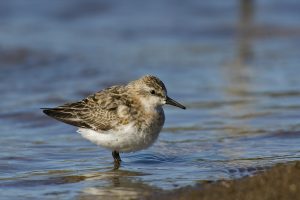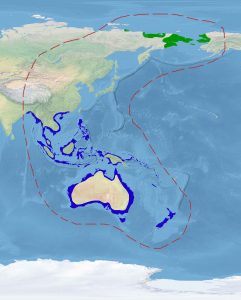Gut microbiota of a long-distance migratory bird demonstrates resistance against invading environmental microbes
By Elana Rusnak, SRC intern and MS student
Just as with humans, animals have many kinds of bacteria in their gut that helps them with acquiring the nutrients from the food they eat, as well as boosting their immune system (Khosravi & Maxmanian, 2013). Many species that migrate from breeding to non-breeding grounds during the year may have an increased risk of transmitting harmful bacteria that they pick up from sites they stop at along the way. If migrant guts have a “colonization resistance” to harmful microbes, they will be less likely to carry them along their migratory routes. However, it is also possible that gut communities may become unstable when continually exposed to new strains of bacteria. Migratory species are faced with changes in geography, diet, and physiology, which are all factors that contribute to changes in gut bacteria composition.

Red-necked Stint (Calidris ruficollis) By Patrick_K59 – https://commons.wikimedia. org/w/index.php?curid=45909879
In a study by Risley et al. earlier this year, they looked at the invasion resistance of the gut of the Red-necked stint (Calidris ruficolis) to microbes they ate at various sites along their migratory route (Siberia to Australia). They chose this study species for a few reasons: they migrate to their non-breeding grounds and stay there for at least a year and a half afterward, so it’s easy to track birds that have recently migrated and those that have been there for a long time. These shorebirds also eat by sifting through coastal sediments with their bills, so their food source is readily available to study at known locations. The researchers believed that recently migrated birds would have a different gut community than resident birds, and that their gut community would become more like that of the resident birds over time.

Red-necked stint distribution, with non-breeding areas in blue. By Nrg800 – Own work, https://commons. wikimedia.org/w/index.php? curid=11336387
They caught and sampled 71 total stints in Australia in two groups: recently migrated birds, and resident birds. They isolated and analyzed gut community DNA from each individual, and also sampled sediments from along the migratory route, and compared the bacteria in these sediments to what was found in the guts.
Contrary to what they predicted, less than 0.1% of the gut community in migrating birds came from the local foraging sediments. They found almost no difference in the gut microbes of the recently migrated birds and the resident birds, suggesting that this particular species does not incorporate sediment microbes into their gut as they migrate. However, they did find a high abundance of a single strain of bacteria in the recently migrated birds that decreased over the course of the non-breeding season. This strain may be related to an immune response to compensate for being exposed to so many different kinds of bacteria on their migratory route.
These results show that the Red-necked stint is highly resistant to microbial invasions that are taken in with their food as they migrate. The researchers suggest that this resistance decreases their susceptibility to infection as they visit new locations on their route. Future research could elucidate if this resistance is only found in migratory species, and to further understand the relationship between microbe invasion and infection risk.
Works Cited
Khosravi, A., & Mazmanian, S. K. (2013). Disruption of the gut microbiome as a risk factor for microbial infections. Current opinion in microbiology, 16(2), 221-227.
Risely, A., Waite, D., Ujvari, B., Klaassen, M., & Hoye, B. (2017). Gut microbiota of a long‐distance migrant demonstrates resistance against environmental microbe incursions. Molecular ecology.
